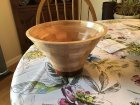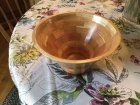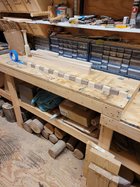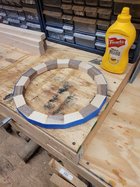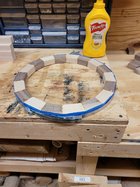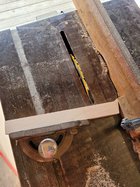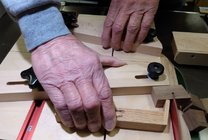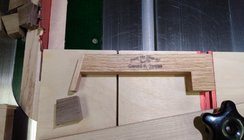-
It's time to cast your votes in the July 2025 Turning Challenge. (click here for details) -
Congratulations to Michael Foster for "Costa II" being selected as Turning of the Week for July 28th, 2025 (click here for details) -
Welcome new registering member. Your username must be your real First and Last name (for example: John Doe). "Screen names" and "handles" are not allowed and your registration will be deleted if you don't use your real name. Also, do not use all caps nor all lower case.
You are using an out of date browser. It may not display this or other websites correctly.
You should upgrade or use an alternative browser.
You should upgrade or use an alternative browser.
Segmented bowl
- Thread starter Rusty Nesmith
- Start date
john lucas
AAW Forum Expert
Good job.
- Joined
- Feb 28, 2021
- Messages
- 1,663
- Likes
- 1,451
- Location
- Roulette, PA
- Website
- www.reallyruralwoodworks.com
Looks like some nice work.. better than I've done with just plain bowls, so far.. hard to believe that's your "first time" - looks like it was done by an expert.. 
The pros are a lot less mess and faster to turn. The cons are it takes longer to cut and glue everything. It was a fun process and I will definitely make some more.
When you consider the amount of time it takes a green rough turned bowl to dry enough to finish the segmentation would be a lot quicker start to finish. You would just have quite a bit more hands on time. I do like the fact that the glueup can give you 100 percent side grain to turn.The pros are a lot less mess and faster to turn. The cons are it takes longer to cut and glue everything. It was a fun process and I will definitely make some more.
Russ Braun
TOTW Team
Nicely done Rusty! Your alignment looks great and you’ve discovered that scraps is a poor description of left over wood pieces. Gary is correct about side grain, you are also free to build any size vessel blank you want. Looking forward to your future efforts!
Rusty, that is a great looking piece. My complements! Segmenting is a good way to use those scraps that accumulate in a box or bucket. I never throw away anything unless it is real small, cracked or useless in some way. BTW, I use them for pens.
Gary no drying time is one of the best parts. I should have put that in the pros.When you consider the amount of time it takes a green rough turned bowl to dry enough to finish the segmentation would be a lot quicker start to finish. You would just have quite a bit more hands on time. I do like the fact that the glueup can give you 100 percent side grain to turn.
This is my process for making the rings. If anybody sees a problem or easier way feel free to let me know.
I cut the segments on my table saw with the miter gage.
I put glue on the ends and put them on painters tape.
I flip them on their side and roll it into the ring.
I put a hose clamp on and tighten it up to get the ring tight.
I don’t have a picture of it but I made a 12” disc sander to go on my lathe to sand them flat to glue the rings together.
I cut the segments on my table saw with the miter gage.
I put glue on the ends and put them on painters tape.
I flip them on their side and roll it into the ring.
I put a hose clamp on and tighten it up to get the ring tight.
I don’t have a picture of it but I made a 12” disc sander to go on my lathe to sand them flat to glue the rings together.
Attachments
In segmenting, there is really no absolute right way (or wrong way) to do things ... some just work better than others. It looks like this process is working for you!This is my process for making the rings. If anybody sees a problem or easier way feel free to let me know.
john lucas
AAW Forum Expert
I'm following. That's how I did it early on. Lately after years of not making segmented pieces I put glue on both piece and push them together lightly. I don't try to squeeze the glue out. I do this on a board that is flat and waxed. When I get the ring assembled I put the hose clamp on and squeeze the ring fairly snug. then I use a plastic mallet to drive them all flat and snug up the clamp further. I wipe off the glue on the top surface. I have done what you do years ago and still do on compound miter rings.
John I do the same thing. I snug the clamp and tap them with a rubber mallet to even them out.
Rusty from the looks of your joints the angle must be pretty exact if you can glue the entire ring at once. To add to what John said I cover my assembly board with poly sheeting then take the first piece put some glue on it and run the 2nd piece against it to evenly spread the glue on both then put glue on the other side of the second piece and rub the 3rd piece. Set the 3rd piece down and push 1 & 2 together, then the 3rd to the 4th ETC. and when all of the joints have glue put the hose clamp on, hammer the joints even and wash the glue off of both sides. Note; I flatten the rings with my drum sander and excess glue is hard on the sanding belt but the joint between rings is near perfect.I'm following. That's how I did it early on. Lately after years of not making segmented pieces I put glue on both piece and push them together lightly. I don't try to squeeze the glue out. I do this on a board that is flat and waxed. When I get the ring assembled I put the hose clamp on and squeeze the ring fairly snug. then I use a plastic mallet to drive them all flat and snug up the clamp further. I wipe off the glue on the top surface. I have done what you do years ago and still do on compound miter rings.
I had a bit of an issue with joint glue starvation. To address I changed to applying glue twice. Arrange all segments in a circle with a 1/2” or so gap between them, then work my way around the circle applying glue to each segment side, then around a 2nd time, push it all together and hose clamp. Never get my angle perfect enough for me, so I use dowels and glue 1/2 rings, sand flat, glue 1/2’s together -always get tight joints with plenty of glue. I use butcher paper, with a plastic coating on one side, on the bench to do gluing.
My brother is cutting a set of Wedgies for me on his CNC router. Also doing the parts for the Wedgie Sled. (He’s bored of making flags )
I’m hoping to cut segments accurate enough to glue the entire ring at once.
I’m hoping to cut segments accurate enough to glue the entire ring at once.
john lucas
AAW Forum Expert
Doug I ran into the same starvation problem with a mahagony piece I did. I would apply glue to the joint and rub them together. then set the pieces down while I applied glue to the next 2, rub those and set them down. Then go back to the first set and apply more glue and just gently rub them to make sure the glue covered all the surface then put them together lightly. I continue this until the ring has been assembled and then add the band clamp and start squeezing and go through the rest of the process above.
Years ago I did a test on end grain to end grain glue ups and sizing the joint (applying glue and letting it soak in) made a huge difference in the strength.
Years ago I did a test on end grain to end grain glue ups and sizing the joint (applying glue and letting it soak in) made a huge difference in the strength.
My brother is cutting a set of Wedgies for me on his CNC router. Also doing the parts for the Wedgie Sled. (He’s bored of making flags )
I’m hoping to cut segments accurate enough to glue the entire ring at once.
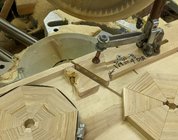
This segment cutting jig will when properly tuned cut accurate segments. The first step is to set the saw as accurately as possible to the required angle, which in 8 segment rings is 22 1/2 degrees. The secondary table is mounted and a set of segments is cut from low grade material and dry fitted to checked for accuracy. This jig also has the advantage of cutting every possible segment from a strip.
I'm hoping to eliminate the tedious angle setting and the need to cut test segments. We'll see...The first step is to set the saw as accurately as possible to the required angle, which in 8 segment rings is 22 1/2 degrees. The secondary table is mounted and a set of segments is cut from low grade material and dry fitted to checked for accuracy. This jig also has the advantage of cutting every possible segment from a strip.
Wedgie Sled will allow cutting the angle accurately enough to glue the ring together all at once. Need to pay attention to getting the sled square and parallel when you make it.
Phil
Phil
I know that my method may seem tedious but by clamping the piece to be cut down and fine tuning the angle you guarantee repeatability.I'm hoping to eliminate the tedious angle setting and the need to cut test segments. We'll see...
How do you adjust the sled and how do you know if the angle is accurate if you don't do a test ring. It only takes seconds of a degree to cause miss fit.Wedgie Sled will allow cutting the angle accurately enough to glue the ring together all at once. Need to pay attention to getting the sled square and parallel when you make it.
Phil
What type of wood is that in your picture Don?
I use the wedgie sled. As long as your wedgies' angles are accurate, it's almost fool proof, which is what I need. I have made numerous items with up to 24 segment rings without having to glue up in halves. I always clamp up the rings before gluing just to make sure there are no gaps. If I'm making a feature ring with multiple cut and glue sequences, the wedgie sled won't work because the pieces get too small to hold safely. Then you have to use another method. There are lots of ways to cut segments and I just find that the wedgie sled eliminates a lot of trial and error, adjustments and 1/2 ring glue ups.
If you are referring to the segment jig post the wood used for test rings is partially rotten black ash.What type of wood is that in your picture Don?
Accuracy depends on the wedgie angle being dead-nuts on and the fence edges exactly parallel with the opposite edge. Presumably the CNC router will take care of this.How do you adjust the sled and how do you know if the angle is accurate if you don't do a test ring. It only takes seconds of a degree to cause miss fit.
Here’s a video explaining the concept and use.
Well I watched the video and I can see that if the setup gauge is an accurate angle that the angle between the 2 fences will be accurate however the cut angle may not be the same on each fence, which is why I shied away from the double fence sled. If I missed the part about getting the the 2 fences to the same cut angle I would be interested to know how it is done. The other problem I see and none of the videos seem to show is the amount of waste on each stick since it seem obvious that you would not be able to safely hold the stick for cutting the maximum amount of segments as I can do with my jig.Accuracy depends on the wedgie angle being dead-nuts on and the fence edges exactly parallel with the opposite edge. Presumably the CNC router will take care of this.
Here’s a video explaining the concept and use.
View: https://m.youtube.com/watch?v=jj1d9OSA2UQ
Any error in the angle of one fence is canceled out by an equal and opposite error on the other. I’ll mark a centerline on the sled and on the wedges. Matching them will make any difference insignificant.
I’m hoping to keep the waste to a minimum by adding toggle clamps to the fences.
I’m hoping to keep the waste to a minimum by adding toggle clamps to the fences.
The fences can be deliberately set off center and if you keep the wedges in sets by marking the upper and back sides the angles still cancel but you get interesting looking segments. You can even cut with the blade off square with this technique for even more interesting glueups. Jerry Bennett has videos on his site illustrating this fact.Well I watched the video and I can see that if the setup gauge is an accurate angle that the angle between the 2 fences will be accurate however the cut angle may not be the same on each fence, which is why I shied away from the double fence sled. If I missed the part about getting the the 2 fences to the same cut angle I would be interested to know how it is done. The other problem I see and none of the videos seem to show is the amount of waste on each stick since it seem obvious that you would not be able to safely hold the stick for cutting the maximum amount of segments as I can do with my jig.
Since you need 3-4" of the "stick" to hold against the Wedgie sled fence, you will need to add this amount of materiel to the length. I tried Gary's blade tilting thing and found that it was very difficult to keep the rings flat while clamping. The compound angle cut made the glued segments slide all over the place. I wouldn't try it again unless I grow some more hands.The other problem I see and none of the videos seem to show is the amount of waste on each stick since it seem obvious that you would not be able to safely hold the stick for cutting the maximum amount of segments as I can do with my jig.
There's lots of way to cut segments. Some methods are easier than others.
- Joined
- Feb 28, 2021
- Messages
- 1,663
- Likes
- 1,451
- Location
- Roulette, PA
- Website
- www.reallyruralwoodworks.com
I haven't tried segmented turning at all yet, however, I am familiar with the issue you speak of.. Solved by: two MDF Cauls with a sheet of wax paper "glue-sticked" (dollar store tube of glue that looks like giant chap-stick) to each face, then assemble and glue segments on one face, position your band/ring clamp lightly around, then apply and lightly clamp the second caul on top of the sandwich, tighten up band clamp... of course, you can cut a hole in middle of the upper caul for sight/finger space to adjust wayward segments as clamping pressure is applied.. or cut your caul(s) to diameter of your rings and adjust from the outside edges... I dunno.. it worked great for a 6-sided piece of flatwork I was working with that I used compound angles on..I tried Gary's blade tilting thing and found that it was very difficult to keep the rings flat while clamping. The compound angle cut made the glued segments slide all over the place. I wouldn't try it again unless I grow some more hands.
I had already realized that the different angles would cancel out, if as Gary said you mark them to keep them in the proper order.Any error in the angle of one fence is canceled out by an equal and opposite error on the other. I’ll mark a centerline on the sled and on the wedges. Matching them will make any difference insignificant.
I’m hoping to keep the waste to a minimum by adding toggle clamps to the fences.
The addition of a toggle clamp to the fences would require I believe a method to clamp the fence down in the area of the clamp to the sled otherwise operation of the toggle clamp will just raise the fence.
You can even cut with the blade off square with this technique for even more interesting glue ups. Quote from Gary
I have had experience with minor off square cuts and yes it will cancel out the error if you maintain the the order of assembly just like the previously mentioned sled error.
I would guess that if you were to have a significant off square angle that some discs would be needed to sandwich the ring while you draw it together with a band clamp.
I have had experience with minor off square cuts and yes it will cancel out the error if you maintain the the order of assembly just like the previously mentioned sled error.
I would guess that if you were to have a significant off square angle that some discs would be needed to sandwich the ring while you draw it together with a band clamp.
The other problem I see and none of the videos seem to show is the amount of waste on each stick since it seem obvious that you would not be able to safely hold the stick for cutting the maximum amount of segments as I can do with my jig.
Not necessarily ... I have been using this little device for years ... my fingers are a good 3 inches away from the blade and it provides a firm grip on the stock.Since you need 3-4" of the "stick" to hold against the Wedgie sled fence, you will need to add this amount of materiel to the length.
Attachments
I see that your fences are slotted presumably so that when changing angles a new end could be advanced for support right up to the cut and that should cut the waste down to one segment. Do you have any problems with the piece lifting up from the sled?Not necessarily ... I have been using this little device for years ... my fingers are a good 3 inches away from the blade and it provides a firm grip on the stock.
I did see one video where the length stop was attached to the fence and a clamp was fabricated to hold the piece being cut down to the sled for the second cut but I didn't see how he got the first cut made.
I could advance the fences to back up the cut, but in more than 4 years with this sled, I haven't felt the need to. I think the key is a sharp blade and controlled feed rate of the cut.I see that your fences are slotted presumably so that when changing angles a new end could be advanced for support right up to the cut and that should cut the waste down to one segment. Do you have any problems with the piece lifting up from the sled?
I did see one video where the length stop was attached to the fence and a clamp was fabricated to hold the piece being cut down to the sled for the second cut but I didn't see how he got the first cut made.
I have never had an issue with the stock lifting up ... despite a little arthritis, I still have a pretty strong grip. I suppose I could use some 100-grit PSA on the fence edges that contact the stock.
I think I have seen that same video ... that would certainly work, but it seems it would take forever to cut segments for a ring. With my sled and the ramped throat plate I use I can whip through a 48 segment ring in just a few minutes.
I use hold down toggle clamps with good success. The finger saver is a great idea! I use one on chop saw to cut segmented pieces, never thought about using it on wedgie sled. I usually mark the last segment from a previously cut piece and reverse it on the sled so the hold down can hold it. I can cut waste down to less than .5 in.I see that your fences are slotted presumably so that when changing angles a new end could be advanced for support right up to the cut and that should cut the waste down to one segment. Do you have any problems with the piece lifting up from the sled?
I did see one video where the length stop was attached to the fence and a clamp was fabricated to hold the piece being cut down to the sled for the second cut but I didn't see how he got the first cut made.
I like the finger saver idea. Normally, I have a set of plans and I just cut my strips to allow for 3-4 extra inches. There has been a time where I found a flaw in the wood that I had to cut out and the piece got really short. I ended up using a quick grip clamp to hold it to the fence for the last cut or two.

